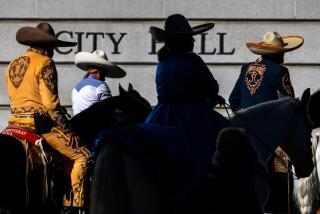A Stripped-Down History of the Hot Rod
- Share via
Hot rodding stirred in the ‘20s, before exploding in the ‘30s and maturing in the ‘40s. Southern California was its temple.
The aim of the game was singular and simple: Better Detroit by subtracting weight and adding power to create a car that would belch in the face of the devil.
Fords, by their availability and adaptability, were the cars of choice in the Depression years, when few working people could afford new cars. Fenders and bumpers were stripped. Large rear tires were added to small front ones. Bodies were lowered, dropped in front and jacked up in the rear.
A polished engine became the chrome badge of courage. First the Flathead Four and then V-8 engines were obligatory. As were Winfield and Edelbrock heads. Also Offenhauser manifolds and Stromberg carburetors.
Some owners added streamlining. Muroc Dry Lake, now host to shuttle landings and Edwards Air Force Base, and Utah’s Bonneville Salt Flats became racetracks. Speeds topped 170 m.p.h.
When Johnny came marching home from World War II, cars were in short supply. That heightened the back-yard hobby of hot rods but with a difference: Now cars built to race must be daily drivers, and that meant making them pretty.
Clubs formed across California. The Gazelles. Road Hogs. Geargrinders and Side-winders. Drivers and nicknames gained their 15 minutes of fame. “Axle” Stewart. “Acmo” McLaughlin. “Bub” Marcia. And Dan Gurney, a kid from Orange County who went on to impress Formula One crowds in Europe.
There was clandestine racing on county roads. It really didn’t matter if police appeared. Whenever push came to shove, a hot rod shoved-off faster than any cop car.
George Barris of North Hollywood, a street racer and pioneer builder who remains a legendary customizer, remembers his escapes. They weren’t always clean. “Once I got home with bullet holes in the trunk of my car,” he says.
The late ‘40s were hot rodding’s gamy days. Cars hung out at the Piccadilly near Sepulveda Boulevard. As Barris told Tom Wolfe in an interview that formed a classic essay, “The Kandy-Kolored Tangerine-Flake Streamline Baby”: “A guy goes up to another guy’s car and looks it up and down like it has gangrene or something, and he says: ‘You wanna go?’
“Or if it was a real grudge match for some reason, he’d say, ‘You wanna go for pink slips?’ The registrations on the cars were pink; in other words, the winner got the other guy’s car.
“Well, as soon as a few guys had challenged each other, everybody would ride out onto this stretch of Sepulveda Boulevard or the old divided highway in Compton, and the guys would start dragging, one car on one side of the center line, the other car on the other.
“Go. For a quarter of a mile. It was wild. Some nights there’d be a thousand kids lining the road to watch, boys and girls, all sitting on the sides of their cars with the lights shining across the highway.”
Hounded by police and condemned by government, hot rodders were forced to legitimacy in the early ‘50s.
Cars left the streets and began racing at Southern California airports. So was born drag racing and a new era of automobiles.
Oval track racing siphoned off more cars and drivers. Then low riders, custom rods, sports cars and muscle cars. Even Barris began building vehicles more for outlandish looks than outstanding performance.
And hot rodding was left to nostalgia.
Or--to plagiarize posters and T-shirts sold by artist Kent Bash any Friday cruisin’ night at Bob’s Big Boy in Canoga Park--hot rodding is lost in the ‘50s.
More to Read
Go beyond the scoreboard
Get the latest on L.A.'s teams in the daily Sports Report newsletter.
You may occasionally receive promotional content from the Los Angeles Times.










